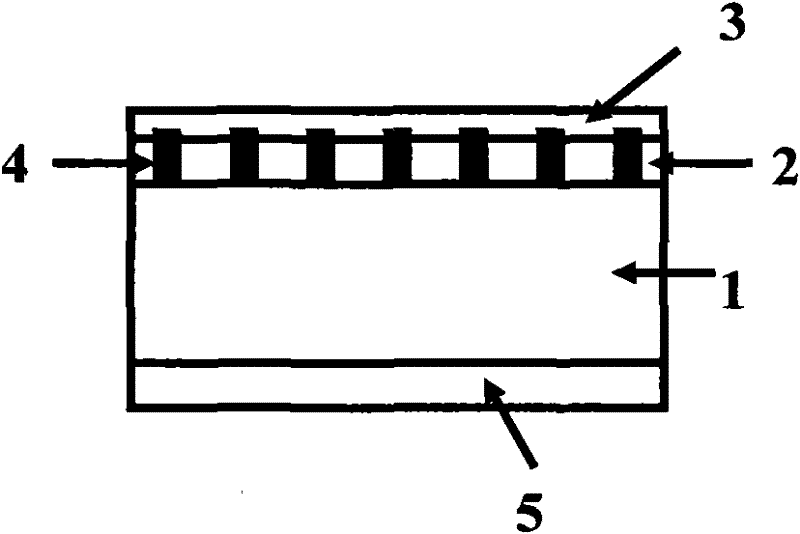Method for improving efficiency of solar cell
A solar cell and efficiency technology, applied in circuits, photovoltaic power generation, electrical components, etc., can solve problems such as reducing the self-absorption of silicon quantum dots, and achieve the effect of improving efficiency
- Summary
- Abstract
- Description
- Claims
- Application Information
AI Technical Summary
Problems solved by technology
Method used
Image
Examples
Embodiment 1
[0022] The 2.5nm silicon quantum dots whose surface was passivated by hydrogen were obtained from the plasma preparation system of silicon quantum dots. The standard deviation of the size distribution of silicon quantum dots is 10% of the mean size. Put the silicon quantum dots in a mixture of trimethylbenzene and n-dodecene (the volume ratio of trimethylbenzene and n-dodecene is 10:7), and carry out a hydrosilylation reaction at a temperature of 220°C until the mixed solution becomes clear . Thereby obtaining silicon quantum dots with 12 carbon organic molecular chains on the surface. The surface-modified silicon quantum dots were separated from the mixture by centrifugation, and then dispersed in toluene. The resulting silicon ink concentration was 150 g / L. Silicon quantum dots in silicon ink are excited by light with a wavelength of 325 nanometers, and the fluorescence emitted is mainly concentrated in the region near the wavelength of 600 nanometers, and the fluorescenc...
Embodiment 2
[0024] 3nm silicon quantum dots whose surface was passivated by hydrogen were obtained from the plasma preparation system of silicon quantum dots. The standard deviation of the size distribution of silicon quantum dots is 15% of the mean size. The silicon quantum dots are placed in a mixed solution of ethanol and acrylic acid (the volume ratio of ethanol and acrylic acid is 3:1), and a hydrosilylation reaction is carried out under ultraviolet radiation until the mixed solution becomes clear. Thus, silicon quantum dots with polyacrylic acid attached to the surface are obtained. The surface-modified silicon quantum dots are separated from the mixed solution by centrifugation, and then dispersed in water. The resulting silicon ink concentration was 120 g / L. Silicon quantum dots in the silicon ink are excited by light with a wavelength of 325 nanometers, and the fluorescence emitted is mainly concentrated in the region near the wavelength of 680 nanometers, and the fluorescence ...
Embodiment 3
[0026] 7nm silicon quantum dots whose surface was passivated by hydrogen were obtained from the plasma preparation system of silicon quantum dots. The standard deviation of the size distribution of silicon quantum dots is 30% of the mean size. Put silicon quantum dots in air and they oxidize naturally at room temperature. After 70 days of natural oxidation, put the silicon quantum dots with an oxide film on the surface into a mixed solution of ethanol and water (the volume ratio of ethanol and water is 5:2), and use a shear emulsifier to disperse the silicon quantum dots as much as possible. When the shear rate is 2000r / min and the reaction temperature is 70°C, add 25% mass ratio of silane coupling agent CH 2 =C(CH 3 )COO(CH 2 ) 3 Si(OCH 3 ) 3 , the pH value of the system was adjusted to about 4 with oxalic acid solution, and the surface-modified silicon quantum dots were obtained after 3 hours of reaction. After centrifugation, the silicon quantum dots were redispersed...
PUM
| Property | Measurement | Unit |
|---|---|---|
| size | aaaaa | aaaaa |
| thickness | aaaaa | aaaaa |
| wavelength | aaaaa | aaaaa |
Abstract
Description
Claims
Application Information
 Login to View More
Login to View More - R&D Engineer
- R&D Manager
- IP Professional
- Industry Leading Data Capabilities
- Powerful AI technology
- Patent DNA Extraction
Browse by: Latest US Patents, China's latest patents, Technical Efficacy Thesaurus, Application Domain, Technology Topic, Popular Technical Reports.
© 2024 PatSnap. All rights reserved.Legal|Privacy policy|Modern Slavery Act Transparency Statement|Sitemap|About US| Contact US: help@patsnap.com









